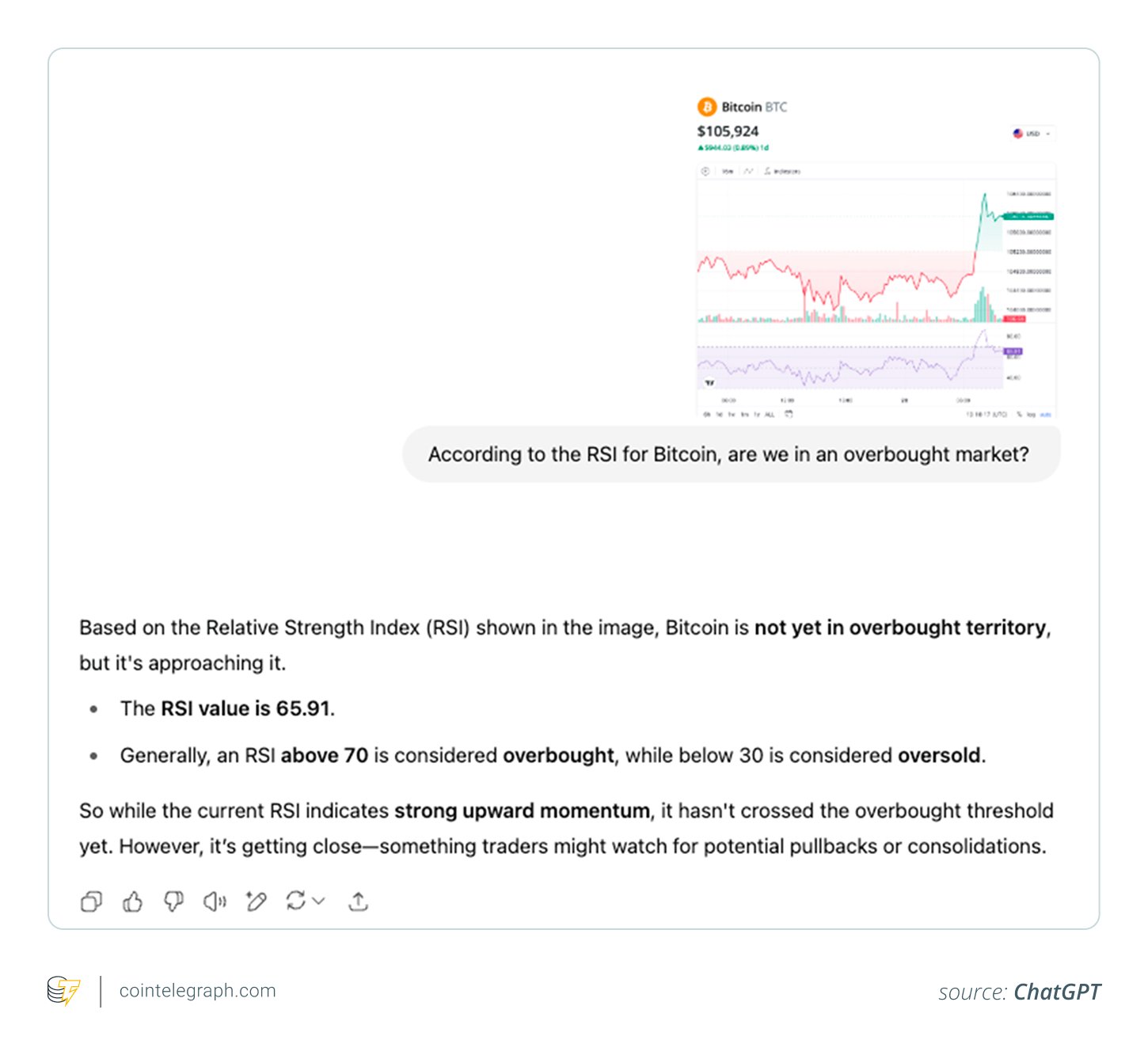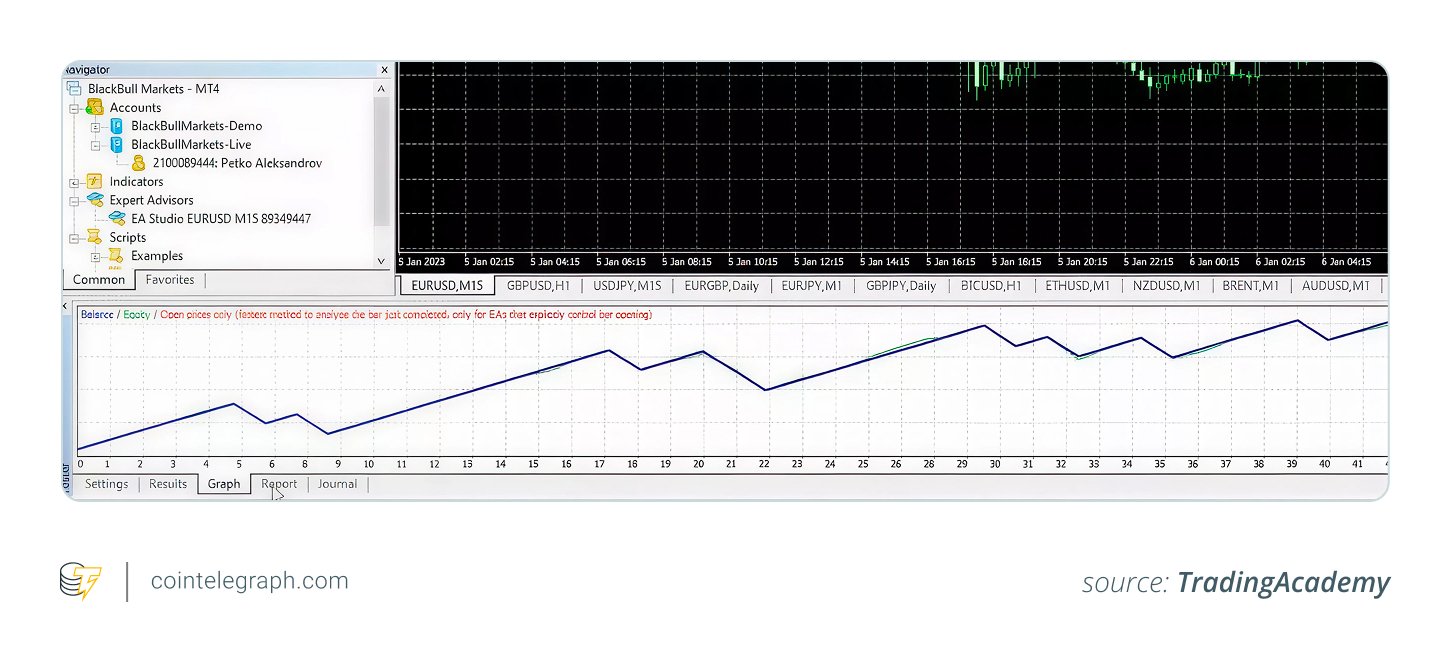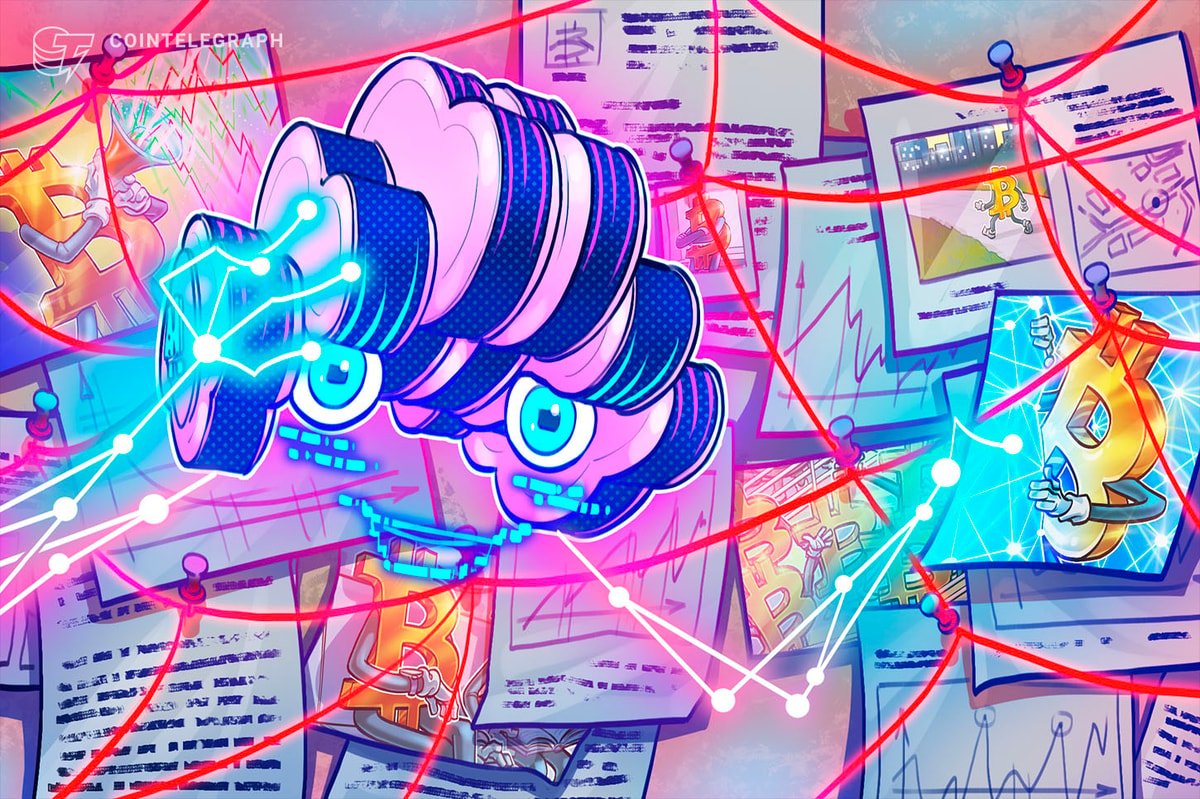How ChatGPT helps analyze Bitcoin trends
ChatGPT is a generative AI model developed by OpenAI, built on the GPT‑4 architecture. It’s designed to generate human-like responses across a wide range of topics, using knowledge drawn from an enormous training set of text, books, code and online content.
When it comes to cryptocurrency, ChatGPT doesn’t have real-time access to Bitcoin (BTC) price feeds or live market charts, but that doesn’t mean it’s useless for traders. With the right inputs — historical price data, sentiment indicators and technical metrics — ChatGPT becomes a powerful analytical tool.
It can help structure Bitcoin price forecasts, identify trends or even simulate crypto trading strategies when paired with the right data.
This is where ChatGPT Bitcoin analysis becomes useful. Its strength lies in interpreting context: combining past performance, technical indicators and market sentiment to support better decision-making.
Did you know? In 2025, around 77% of consumer devices already use some form of AI.
How to predict Bitcoin with AI
How exactly do traders predict Bitcoin with AI, specifically, with ChatGPT?
Many begin by feeding it structured prompts that include market sentiment, on-chain metrics and technical analysis indicators.
For instance, crypto trend prediction with GPT might start by parsing news headlines, sentiment on X, Reddit discussions or expert commentary. This allows ChatGPT to gauge whether the overall mood is bullish or bearish, a key insight in a market where Bitcoin volatility trends often follow shifts in narrative.
When given technical indicators such as the relative strength index (RSI), moving average convergence/divergence (MACD), moving averages or trading volume, ChatGPT financial tools can contextualize them using historical relationships. For example, if RSI exceeds 70 and volume surges, ChatGPT might flag the market as overbought — a classic signal of potential pullback based on Bitcoin price history.

Integrating onchain analytics like whale wallet activity, hashrate trends or exchange inflows/outflows can enhance this picture. ChatGPT can help interpret such data and suggest whether accumulation or distribution phases are forming, especially when paired with external tools like TradingView or LunarCrush.
From bots to AI agents: Evolving Bitcoin trading with ChatGPT
Some advanced traders build AI Bitcoin trading strategies that combine ChatGPT with APIs or dashboards.
These setups let ChatGPT pull from multiple data sources — like social sentiment APIs, technical indicators or trading signals — and generate backtestable models or even functional code for ChatGPT trading bots and ChatGPT-powered AI agents.

In this setup, the trader becomes the architect while ChatGPT acts as the signal synthesizer, combining disparate data points into actionable insights.
This type of workflow sits at the cutting edge of AI in cryptocurrency, where trading bots vs. AI becomes a question of adaptability: Traditional bots follow rules, while ChatGPT can evolve strategies in response to shifting conditions.
What the research says about ChatGPT crypto trading insights
Multiple studies suggest that AI — and even ChatGPT-enhanced systems — can outperform both manual and conventional machine learning models in predicting crypto price movements.
A peer-reviewed study published in Frontiers in Artificial Intelligence compared various forecasting models for Bitcoin from 2018 to 2024.
The machine learning Bitcoin forecast using a neural ensemble strategy returned a staggering 1,640%, compared to just 305% for standard machine learning models and 223% for a buy-and-hold approach.
Even after applying a 1% per-trade cost, the net return was over 1,580%, showcasing the edge of dynamic, AI-driven strategies.
Transformer-based architectures (akin to GPT) that fuse onchain analytics with Bitcoin market sentiment from social data have also outperformed legacy models in both return and risk control. These tools reduce drawdowns by anticipating volatility through real-time sentiment and technical signals.
But here’s the key: These results don’t come from ChatGPT alone. Instead, they reveal the potential of using ChatGPT for crypto trading insights when it’s embedded in a broader system — one that includes real-time data, prompt logic and post-analysis validation.
Real‑world machine learning Bitcoin forecast: How traders predict Bitcoin with AI
Some of the most compelling ChatGPT crypto trading insights come from real setups used by active traders.
For instance, a case study on TradingView used OpenAI’s GPT-based “o3 Pro” model to assess the Sui (SUI) token. The system analyzed 38 real-time indicators — covering technical metrics, Binance order-book flows, on-chain usage and social sentiment — to produce a structured, real-time forecast. It flagged breakout compression near key support and resistance levels, offering a valuable AI crypto forecast.
These setups are increasingly common. Traders input screenshots of candlestick charts, readouts from indicators like RSI or Bollinger Bands and API-based data sets from platforms like LunarCrush or TradingView. ChatGPT trading bots built around these workflows can then draft buy/sell signals, PineScript strategies or even generate tailored MQL5 code (the programming language used to build custom trading algorithms for MetaTrader 5).
Some communities now maintain prompt libraries that walk users through nine distinct workflows, ranging from strategy development and backtesting to journaling trades or detecting fakeouts across multiple timeframes.
By combining human intuition with AI tools for traders, these hybrid environments demonstrate how predicting Bitcoin with AI doesn’t mean full automation — it means deeper, faster synthesis of data and sentiment.
Did you know? AI models like ChatGPT organize meaning across 66 dimensions, forming mental “maps” of ideas, much like the human brain groups related concepts. That’s how they know an “apple” is closer to “fruit” than to “laptop,” even though both might show up in your shopping cart.
Limits of ChatGPT in Bitcoin price prediction
Despite its strengths, ChatGPT Bitcoin analysis is fundamentally constrained by design.
Because ChatGPT lacks direct access to real-time data, it cannot deliver live market calls or react instantly to volatile swings. Bitcoin market sentiment, order book data, macroeconomic news — none of it is streamed directly into the model. Instead, all insights depend on the user’s ability to feed in structured data from external sources.
This limitation also means ChatGPT cannot reliably detect market manipulation. Sophisticated schemes like spoofing, wash trading or flash crashes often unfold too quickly and subtly for a text-based model to identify, especially without live onchain analytics or real-time feeds.
Another well-documented issue is overconfidence. In several cases, users report that ChatGPT will initially resist making predictions until given exhaustive prompts, but once it does respond, it might deliver outputs that sound authoritative yet remain untested or speculative. This can lead to hallucinations, fabricated but plausible-sounding insights that carry risk if acted upon blindly.
Finally, broader research from BCG and Harvard Business School warns against overreliance on generative AI. In high-stakes tasks requiring strategic judgment, GPT-4 users sometimes performed 23% worse than control groups — a cautionary tale for crypto traders considering replacing intuition with automation.
Bitcoin price prediction: ChatGPT is a tool, not a prophet
Can ChatGPT predict Bitcoin’s next move? Not directly. But it can help you become a better analyst.
With properly structured prompts and high-quality inputs, ChatGPT can surface patterns, interpret sentiment, decode technical signals and accelerate strategy development. It bridges the gap between intuition and data, but it doesn’t eliminate the need for human oversight.
In the debate of trading bots vs. AI, ChatGPT doesn’t replace bots — it helps you build smarter ones. It won’t deliver absolute answers, but it can offer structured, explainable perspectives, especially when used alongside traditional crypto technical analysis methods.
When trading on today’s volatile markets, ChatGPT financial tools are best viewed as part of a broader arsenal — where AI helps parse complexity but doesn’t shoulder responsibility alone.
